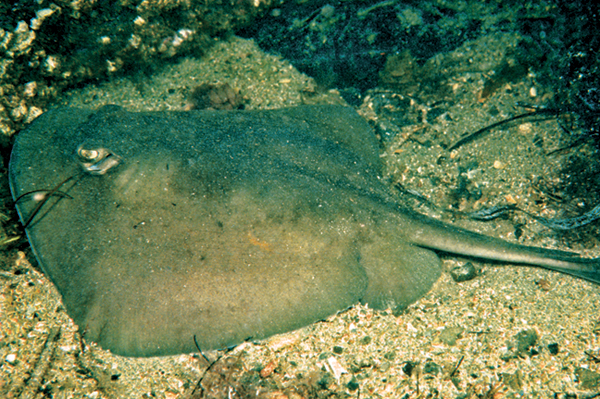Western Shovelnose Stingaree, Trygonoptera mucosa (Whitley 1939)
Other Names: Bebil, Kejetuck, Western Stingaree, Yellow-spotted Stingaree

Western Shovelnose Stingaree, Trygonoptera mucosa. Source: Rudie H. Kuiter / Aquatic Photographics. License: All rights reserved
Summary:
A greyish, greyish-brown to blackish stingaree often with irregular, paler yellowish blotches scattered on the disc, and a grey to black caudal fin. The underside is whitish or yellow with dark pelvic fins and a dark margin on the disc. The Western Shovelnose Stingaree lacks a dorsal fin on the tail.
Cite this page as:
Bray, D.J. 2022, Trygonoptera mucosa in Fishes of Australia, accessed 06 Jul 2025, https://fishesofaustralia.net.au/home/species/4285
Western Shovelnose Stingaree, Trygonoptera mucosa (Whitley 1939)
More Info
|
Distribution |
Endemic to southern Australia from Glenelg, South Australia, to Perth, Western Australia. The species is common in shallow areas of the Great Australian Bight. Usually inhabits sandy areas near seagrass beds in shallow sheltered bays. |
|
Features |
Disc subcircular, wider than long, anterior edge obtuse; snout fleshy, tip slightly extended; eyes of moderate size (20–27% preocular snout length); posterior margin of spiracles rounded; 7–9 minute papillae on mouth floor, immediately behind teeth; internasal flap skirt-shaped, posterior angle not extended into distinct lobe; tail of moderate length (71–91% disc length); no dorsal fin; caudal fin lanceolate. |
|
Biology |
Attains 17 years of age. Males mature at around 31-34 cm TL and 2 years of ag; females mature at around 5 years of age. Fecundity is low, with females giving birth to 1-2 pups/year; size at birth is ~17 cm TL. |
|
Fisheries |
Taken as incidental by-catch in the Great Australian Bight Trawl Sector of the Southern and Eastern Scalefish and Shark Fishery, and in the South Australian Prawn Fisheries and in scallop and prawn trawl fisheries off Perth and Mandurah, Western Australia. The species is discarded and is not known to be sold commercially. |
|
Etymology |
The specific name is from the Latin mucosus (= mucous, slimy), in reference to what Whitley describes as the “extremely slimy” back of this species. |
|
Species Citation |
Urolophus mucosus Whitley 1939. Aust. Zool. 9(3): 257. Type locality: King George Sound, Western Australia. |
|
Author |
Bray, D.J. 2022 |
|
Resources |
Western Shovelnose Stingaree, Trygonoptera mucosa (Whitley 1939)
References
Adams, K.R., Fetterplace, L.C., Davis, A.R., Taylor, M.D. & Knott, N.A. 2018. Sharks, rays and abortion: The prevalence of capture-induced parturition in elasmobranchs. Biological Conservation 217: 11–27.
Gomon, M.F., Yearsley, G.K. & Last, P.R. 2008. Family Urolophidae. 125-137 pp. in Gomon, M.F., Bray, D.J. & Kuiter, R.H. (eds). Fishes of Australia's Southern Coast. Sydney : Reed New Holland 928 pp.
Hyndes, G.A., Platell, M.E., Potter, I.C. & Lenanton, R.C.J. 1999. Does the composition of the demersal fish assemblages in temperate coastal waters change with depth and undergo consistent seasonal changes? Marine Biology 134: 335-352.
Kuiter, R.H. 1993. Coastal Fishes of South-eastern Australia. Bathurst : Crawford House Press 437 pp.
Kyne, P.M. & White, W.T. 2019. Trygonoptera mucosa. The IUCN Red List of Threatened Species 2019: e.T60082A68648164. http://dx.doi.org/10.2305/IUCN.UK.2019-1.RLTS.T60082A68648164.en. Downloaded on 13 July 2019.
Last, P.R & Gomon, M.F. 1987. New Australian fishes. Part 15. New species of Trygonoptera and Urolophus (Urolophidae). Memoirs of Museum Victoria 48(1): 63-72 https://doi.org/10.24199/j.mmv.1987.48.15
Last, P.R. & Gomon, M.F. 1994. Family Urolophidae. pp. 172-181 figs 150-159 in Gomon, M.F., Glover, C.J.M. & Kuiter, R.H. (eds). The Fishes of Australia's South Coast. Adelaide : State Printer 992 pp. 810 figs.
Last, P.R. & Stevens, J.D. 1994. Sharks and Rays of Australia. Canberra : CSIRO Australia 513 pp. 84 pls.
Last, P.R. & Stevens, J.D. 2009. Sharks and Rays of Australia. Collingwood : CSIRO Publishing Australia 2, 550 pp.
Last, P.R. & Yearsley, G.K. 2008. Trygonoptera galba sp. nov., a new stingaree (Myliobatoidei: Urolophidae) from southwestern Australia. pp. 269-274 in Last, P.R., White, W.T. & Pogonoski, J.J. (eds). Descriptions of new Australian chondrichthyans. CSIRO Marine and Atmospheric Research Paper No. 022: 1-358
Last, P.R., Yearsley, G.K. & White, W.T. 2016. Family Urolophidae, pp. 676-705 in Last, P.R., White, W.T., de Carvalho, M.R., Séret, B., Stehmann, M.F.W. & & Naylor, G.J.P. (eds) Rays of the World. Melbourne: CSIRO Publishing, 800 pp.
McKay, R.J. 1966. Studies on Western Australian sharks and rays of the families Scyliorhinidae, Urolophidae and Torpedinidae. Journal of the Royal Society of Western Australia 49(3): 65-82 figs 1-6
Platell, M.E. & Potter, I.C. 2001. Partitioning of food resources amongst 18 abundant benthic carnivorous fish species in marine waters on the lower west coast of Australia. Journal of Experimental Marine Biology and Ecology 261: 31-54.
White, W.T., Hall, N.G. & Potter, I.C. 2002. Reproductive biology and growth during pre- and postnatal life of Trygonoptera personata and T. mucosa (Batoidea: Urolophidae). Marine Biology 140: 699–712.
White, W.T. & Potter, I.C. 2005. Reproductive biology, size and age compositions and growth of the batoid Urolophus paucimaculatus, including comparisons with other species of the Urolophidae. Marine and Freshwater Research 56(1): 101-110.
Whitley, G.P. 1939. Taxonomic notes on sharks and rays. The Australian Zoologist 9(3): 227-262 figs 1-18 pls 20-22 See ref at BHL
Whitley, G.P. 1940. The Fishes of Australia. Part 1. The sharks, rays, devil-fish, and other primitive fishes of Australia and New Zealand. Sydney : Roy. Zool. Soc. N.S.W. 280 pp. 303 figs.
Yearsley, G.K. & Last, P.R. 2016. A new genus of stingarees (Myliobatiformes: Urolophidae) with comments on other urolophid genera and an annotated checklist of species. pp. 35-40, in Last, P.R., White, W.T., Carvalho, M.R. de, Séret, B., Stehmann, M.F.W. & Naylor, G.J.P. (eds) Rays of the World. Clayton South, Victoria : CSIRO Publishing 790 pp.
Yearsley, G.K., Last, P.R. & Gomon, M.F. 2008. Trygonoptera imitata sp. nov., a new stingaree (Myliobatoidei: Urolophidae) from southeastern Australia. pp. 261-268 in Last, P.R., White, W.T. & Pogonoski, J.J. (eds). Descriptions of new Australian chondrichthyans. CSIRO Marine and Atmospheric Research Paper No. 022: 1-358




